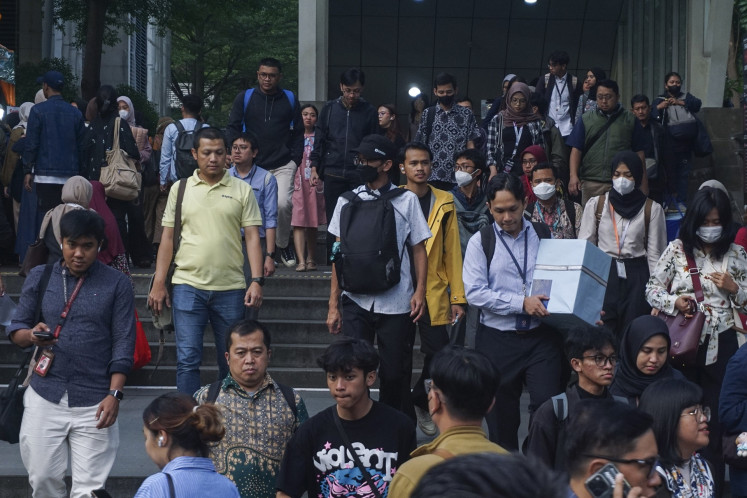Popular Reads
Top Results
Can't find what you're looking for?
View all search resultsPopular Reads
Top Results
Can't find what you're looking for?
View all search resultsSamuel Wattimena levels up Maluku's Tanimbar woven fabric
Indonesia has countless traditional fabrics with exceptional motifs based on local wisdom
Change text size
Gift Premium Articles
to Anyone
Indonesia has countless traditional fabrics with exceptional motifs based on local wisdom. Tenun ikat (woven fabric) from Tanimbar of Southeast Maluku is one of them.
Prominent fashion designer Samuel Wattimena gave his all ' his heart and passion ' to learn, develop and use the fabric for his collection.
And he presented 20 creations that are made of, and inspired by, the province's signature woven fabrics in a recent show, titled Samuel Wattimena's Showcase: Evolution of Tanimbar Ikat Woven Cloth, held at the Textile Museum in Jakarta.
The designer, who has been developing traditional fabrics around the country by empowering local people since 1985, has successfully created a number of collections that combine traditional material with modern cutting ' without losing the Indonesian nuance.
And with a good approach, he hoped Tanimbar woven fabric could enter, and gain acceptance from, the international market.
'Woven fabric of Southeast Maluku is a signature piece of Maluku that has become a legacy for many generations [in that area]. Sadly, modernity seems to overshadow [the fabric's] existence,' he says.
'Over the past few years, I've been intensely improving the quality of Southeast Maluku's woven cloths and diversifying them in a hope the effort would open up ways for people there to improve their earnings and make them economically independent.'
Out of the new collection, the 54-year-old designer transformed the artistic cloth into jackets, blazers and printed clothes that style into pants for men and women, blouses, dresses and skirts for the women's collection.
Most of Samuel's drawings showcase elegance and structured cuttings with strong traditional nuances, represented by the woven fabric's motifs, which range from flags and arrows to flowers.
Samuel gave a modern touch to the collection by mixing the weave-based outfits with plain skirts or pants.
He used natural colors like blue, black and maroon, as well as bright colors like yellow and pink.
In a show of his dedication to the true fashion of Indonesia, he did his best in the production process, such as by using digital printing techniques, to ensure the creations come at affordable prices.
'I'm taking my words back. I used to be known as a designer who would never use the [printing] technique because I thought it would be really bad for the economy of local people,' he says.
'But after 10 years [of experience in developing the woven cloth], I decided to use printing because it allows you to make them at an affordable price [for each of the woven cloth]. Not many people can buy a piece of woven cloth at the price of Rp 1.5 million (US$125) or Rp 2 million.'
He said the most important matter now is to make the clothes and the motifs popular.
'I pick commercial motifs ' the ones that are not being used in traditional ceremonies ' and print them,' Samuel explained.
He also combined styling and printing techniques to create the new collection.
'I've changed the threads ' using softer ones ' for the woven cloth. I've also re-designed the motifs, layouts, composition and colors, as well as combined several motifs before putting them together into whole new looks,' he says.
Dealing with traditional clothes for many years has given Samuel a deeper understanding of the nation's heritage.
He discovered thread had become an issue in creating woven cloth, especially in the eastern part of the country, since 1985.
'The closest [thread] distributor is in Surabaya [of East Java]. That's why woven clothes from the east are mostly expensive,' said Samuel, adding that Southeast Maluku has not been able to produce cotton for many years.
'It is not easy to rebuild cotton plantations. So, I'm suggesting [the government] develop natural colorings to give more value to the woven cloth so we could tag it with higher prices. We do need government support because [such development] needs at least 10 hectares of land.'
Next in his plan is to bring Tanimbar woven cloth to the international market through silk material. He is still educating local people on how to produce good quality silk clothes.
'[Silk] is lighter than cotton. [I believe that] tourists prefer to buy silk scarves instead of the cotton ones out of the lightness [of silk] that will not put them into trouble when traveling around.'
' Photos by JP/Ricky Yudhistira










